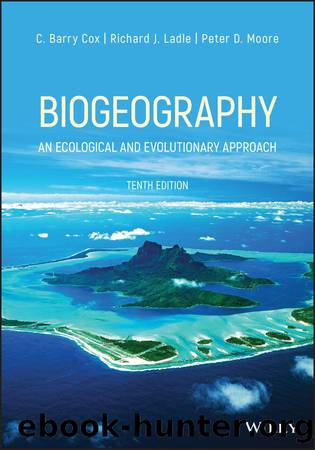Biogeography by unknow

Author:unknow
Language: eng
Format: epub
ISBN: 9781119486855
Publisher: John Wiley & Sons, Inc.
Published: 2020-01-07T00:00:00+00:00
Biogeography of Hydrothermal Vent Faunas
In 1977, marine biologists discovered a dramatically different deepâsea environment containing a fauna that shows a fascinating biogeographical pattern. They are mainly associated with seaâfloor spreading at the midâoceanic ridges, which are at an average depth of 2.5â3.5 km, but also in basins near volcanic island arcs (see Chapter 5). Although the ridges themselves are many hundreds of kilometres wide, they are split by a rift valley only about a kilometre wide, where hot lava is emerging. In some widely scattered areas known as hydrothermal vents, each of which covers only a few hundred square metres, the cold seawater penetrates fissures in the surrounding rocks. The water temperature there may reach 400°C (only the enormous pressures at this depth prevent it from turning to steam), and it reacts chemically with the rocks, so that it becomes rich in metals and sulphur. Where this superheated water emerges and is cooled by the surrounding waters of the ocean, these minerals precipitate out of the fluid. Some of them form solid âchimneysâ, which can be many metres high, while others remain as distinct particles in the rising plume of water, which therefore looks like smoke emerging from a chimney.
Accompanying this extraordinary environment is a unique fauna, whose food web is not based on plants that have trapped the sunâs energy, but instead on chemosynthetic bacteria that extract energy by the oxidation of the chemicals dissolved in the hot fluids, particularly hydrogen sulphide. Some of these bacteria are consumed by grazing or filtering organisms, while others live symbiotically, rather as photosynthetic algae live in corals (see section âCoral reefsâ). They form the food base of a fauna consisting mainly of worms, arthropods and molluscs. The fauna is of low diversity: in the Juan de Fuca section, west of Seattle, there were only 55 species, and 90% of the total number of organisms was contributed by only five species â two gastropod molluscs and three polychaete worms. Such a fauna is typical of other highly disturbed habitats, such as areas being colonized after volcanic eruptions or forest fires. So far, nearly 600 species belonging to 331 genera have been found in vent communities. The commonest microbe found on the vents belongs to a group known as the Epsilonproteobacteria. These bacteria are rare in terrestrial habitats, but appear to flourish in the extreme conditions of the vents. Due to the total darkness, these Epsilonproteobacteria cannot gain energy from the sun and instead survive using chemosynthesis (extracting energy from inorganic chemicals that leach out of rocks). Interestingly, the bacteria flourish in places with little or no oxygen, leading researchers to think that they may be a good model to understand how the first organisms evolved in the extreme volcanic conditions of early Earth, before oxygen even appeared in the atmosphere [22].
The vent communities have now been found at many different locations in the oceanic ridge system. Most of these locations are in the tropics and subtropics, where the weather conditions are more favourable for research, but there are indications that there are others at higher latitudes.
Download
This site does not store any files on its server. We only index and link to content provided by other sites. Please contact the content providers to delete copyright contents if any and email us, we'll remove relevant links or contents immediately.
Essentials of Geology by Stephen Marshak(391)
Spectral Geometry and Inverse Scattering Theory by Huaian Diao & Hongyu Liu(282)
Probably Overthinking It: How to Use Data to Answer Questions, Avoid Statistical Traps, and Make Better Decisions by Allen B. Downey(269)
The Readable Darwin by Pechenik Jan A.;(263)
Hydrocarbon transformations in sediments from the Cathedral Hill hydrothermal vent complex at Guaymas Basin, Gulf of California ââ¬â A chemometric study of shallow seep architecture by unknow(262)
How to succeed in EPSO numerical reasoning tests by Franco Reverte José María(241)
Research and Publication Ethics by Santosh Kumar Yadav(233)
Great Ways to Learn Anatomy and Physiology by McKissock Charmaine;(232)
Mathematical Models in Economics. Lections by Shananin(232)
Quantum International Relations by James Der Derian(231)
Weathering: Types, Processes and Effects: Types, Processes and Effects by Matthew J. J. Colon(228)
Dark Matter in the Universe by John N. Bahcall(225)
Fusion of Defects by Arthur Bartels; Christopher Douglas; André Henriques(214)
Cosmic Rays by Alessandro De Angelis(211)
Mathematics Booster-1 by Singh Manoj Kumar(207)
The Structure of Scientific Inference by Mary B. Hesse(206)
Sampling by Lohr Sharon L.;(205)
Pearls from a Lost City: The LVOV School of Mathematics (History of Mathematics) (History of Mathematics, 40) by Roman Duda(202)
Flora Unveiled by Taiz Lincoln;Taiz Lee;(190)
